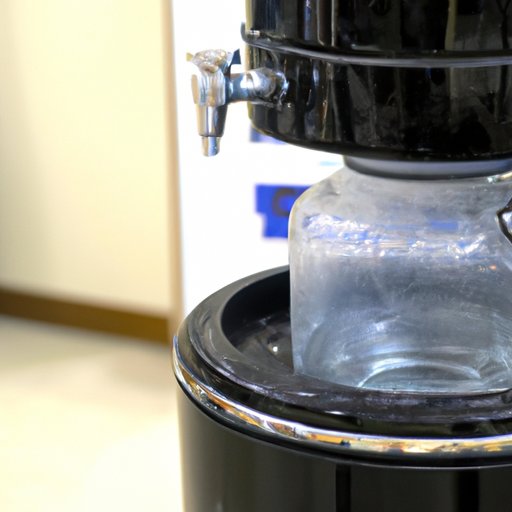
Introduction
Water dispensers provide a convenient and accessible way to stay hydrated at home or in the office. However, they can be a breeding ground for bacteria and mold if not cleaned properly. It is crucial to maintain a clean water dispenser to ensure good health. This article will guide you through a step-by-step process for cleaning a water dispenser, share maintenance tips, highlight eco-friendly cleaning methods, emphasize the benefits of cleaning, provide top do’s and don’ts, and share common cleaning mistakes people make with water dispensers.
Step-by-Step Guide
a. Gather Cleaning Supplies and Tools: Before cleaning your water dispenser, ensure you have all the cleaning supplies and tools you will need. These include a cleaning solution, a soft-bristled brush, a microfiber cloth, a funnel, and a jug of clean water.
b. Empty the Dispenser and Remove Individual Parts: Unplug the dispenser and empty any remaining water. Remove all the individual parts such as the drip tray, the water reservoir, and the faucet.
c. Use Designated Cleaning Solution for Sanitizing: For sanitizing, use a cleaning solution that is specific for water dispensers. This can be purchased from a store or made at home using water and vinegar or lemon juice. Follow the manufacturer’s instructions or use a mixture of one part vinegar or lemon juice to four parts water.
d. Reassemble the Dispenser and Fill with Clean Water: Once you have sanitized all the parts, rinse them thoroughly with clean water and dry them completely with a microfiber cloth. Reassemble the dispenser, including the faucet, and fill it with clean water.
Maintenance Tips
a. Develop a Regular Cleaning Schedule: It is essential to clean your water dispenser at least every three months to avoid buildup from bacteria and mold. However, if you use it frequently, you may need to clean it more often.
b. Use Distilled Water Instead of Tap Water: Using distilled water can minimize mineral buildup and reduce the risk of clogging the dispenser’s filters.
c. Avoid Overfilling the Dispenser: Do not overfill the dispenser because overfilling can cause the water to overflow and seep into the machine, which can lead to mold buildup.
Green Cleaning Methods
a. Use Vinegar or Lemon Juice Instead of Harsh Chemicals: Instead of using harsh chemicals to clean your water dispenser, use vinegar or lemon juice. These are natural and eco-friendly cleaning solutions.
b. Explain the Benefits of These Methods: These eco-friendly cleaning solutions not only clean the dispenser but also help to remove mineral buildup and eliminate odors.
Benefits of Cleaning It
a. Improved Hydration and Immunity: A clean water dispenser allows you to stay hydrated without worrying about harmful bacteria or mold in your water. Proper hydration promotes better health, and it also strengthens your immune system.
b. Disease Prevention: Cleaning your water dispenser regularly can prevent the growth of harmful bacteria and mold, which can cause illness and disease.
Top Do’s and Don’ts
a. Use the Correct Cleaning Products: Always use the recommended cleaning solution and follow the manufacturer’s instructions for sanitizing the dispenser.
b. Avoid Abrasive Materials: Do not use abrasive materials such as steel wool or rough sponge to clean the dispenser. They can scratch and damage the surfaces of the dispenser, which can lead to the growth of bacteria and mold.
c. Unplug the Dispenser before Cleaning: Before cleaning your water dispenser, always unplug it from the power source to avoid the risk of electrical shock.
Common Cleaning Mistakes
a. Failure to Clean Dispenser Regularly: Neglecting to clean your water dispenser regularly can cause harmful bacteria and mold to grow, which can lead to health problems.
b. Failure to Remove Soap Residue: After cleaning your water dispenser, ensure you rinse all the parts thoroughly to avoid leaving behind soap residue, which can be harmful when ingested or inhaled.
c. Failure to Dry the Dispenser Thoroughly after Cleaning: After cleaning, dry all the parts thoroughly with a microfiber cloth before reassembling the dispenser. This prevents the growth of mold and bacteria due to moisture.
Conclusion
It is essential to maintain a clean water dispenser to ensure good health. This article has provided a step-by-step guide, maintenance tips, eco-friendly cleaning methods, emphasized the benefits of cleaning, provided top do’s and don’ts, and shared common cleaning mistakes people make with water dispensers. Follow these guidelines, and you will keep your water dispenser clean, safe, and ready for use anytime.
Call to Action: Share this article with others to educate them on the importance of cleaning their water dispensers.





